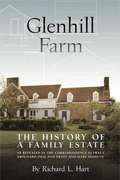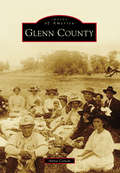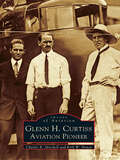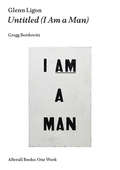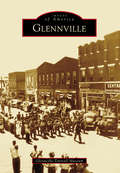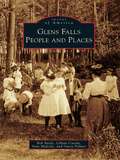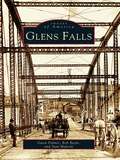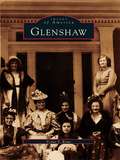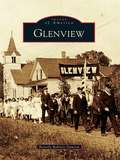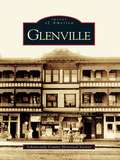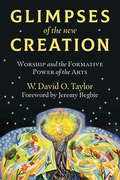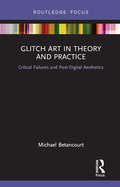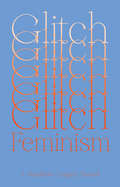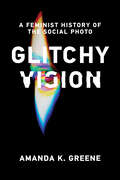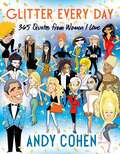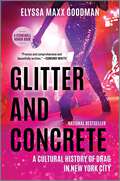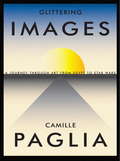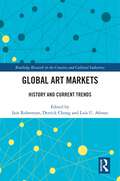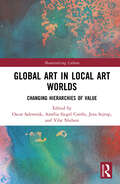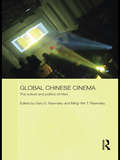- Table View
- List View
Glenhill Farm: The History of a Family Estate, as Revealed in the Correspondence Between Brognard Okie and Ernst and Mary Behrend
by Richard L. HartBy 1930, having developed a highly successful business, the innovative paper manufacturer Ernst Behrend and his wife Mary purchased a number of existing houses and farms to give them sufficient acreage to create a large estate. In 1948 this property became a campus of Penn State University. Known as Penn State Behrend, to this day it retains the original buildings at the historic center of the campus.Based on archival materials, including copious letters between the Behrends and their Philadelphia architect, R. Brognard Okie, this book recounts the planning and development of a unique residence as the country headed into the Great Depression. Letters between the key figures give the reader a glimpse into their thoughts and concerns, including the selection of an architect, the choice of an architectural style, issues involved in planning the estate, and the features and design of the buildings that were constructed or modified. Vintage and modern photographs help convey the nature of the buildings that Okie designed as well as a sense of the Behrends’ lifestyle in the 1930s.An absorbing microhistory of what is now Behrend College, Glenhill Farm provides a window onto a period when new money from industry supported lavish lifestyles, and it reveals how this particular project, conceived and constructed during the Great Depression, was affected by its extraordinary economic circumstances.
Glenn County
by Anna CanonA brief look into the history of Glenn County will show you that Glenn County was created out of the northern portion of Colusa County on March 11, 1891, and was named after the prominent wheat farmer known as the "Wheat King of the World," Dr. Hugh J. Glenn. A more in-depth look at the formation of Glenn County will show that its separation from Colusa County created a fierce contest among the people of those counties. Trains filled with hundreds of citizens traveled to Sacramento to lobby the governor; a few people were even hired from outside of the county to vote for the separation. There are reports that guns were brought to the courthouse for the first election of Glenn County officials in May 1891. To this day, there remains an air of discontent between the two counties.
Glenn H. Curtiss: Aviation Pioneer (Images of Aviation)
by Kirk W. House Charles R. MitchellGlenn Curtiss beat even the Wright brothers (who sued him bitterly) to get pilot's license No. 1 in America. He teamed with Alexander Graham Bell, helped develop the moving wing part known as the aileron, introduced tricycle landing gear, made the first airplane sales, and turned aeronautics into a multimillion dollar business. His innovations ranged from the Curtiss Pusher to the hydroaeroplane, the flying boat, and the Curtiss Jenny. Curtiss, his engines, and his airplanes dominated the world of early aviation on this side of the Atlantic. Glenn H. Curtiss: Aviation Pioneer charts Curtiss's breakneck course across two continents, North America and Europe, setting speed and distance records, experimenting with military applications, always striving for a safer, faster airplane. Fostering both water flyers and shipboard landing, he became the Father of Naval Aviation. But even the skies were not wide enough for the busy brain of Curtiss. Glenn H. Curtiss: Aviation Pioneer also tracks his dizzying ride from a village bicycle shop to record-smashing motorcycle races, futuristic travel trailers, and city building in the Florida land boom.
Glenn Ligon: Untitled (I Am a Man) (Afterall Books / One Work)
by Gregg BordowitzAn illustrated examination of Glenn Ligon's iconic Untitled (I Am a Man) (1988)—a quotation, an appropriated text turned into an artifact.The iconic work Untitled (I Am a Man) (1988) by the important contemporary American artist Glenn Ligon is a quotation, an appropriated text turned into an artifact. The National Gallery of Art in Washington presents the work as a “representation—a signifier—of the actual signs carried by 1,300 striking African American sanitation workers in Memphis, made famous by Ernest Withers' 1968 photographs.” In this illustrated study of the work, Gregg Bordowitz takes the National Gallery's presentation as his starting point, considering the museum's juxtaposition of Untitled (I Am a Man) and the ca. 1935 sculpture, Schoolteacher, by William Edmondson, and the relation of the two terms, “markers” and “signs.”After closely examining the canvas itself, its textures, brushwork, and structure, Bordowitz presents a theoretical framework that draws on the work of American philosopher Charles Sanders Peirce and his theory of Firstness, Secondness, and Thirdness. He makes a case for Thirdness as a function, operation, or law of meaning-making, not limited by the gender, age, ethnicity, race, class, or personal history of the viewer. Bordowitz goes on to examine Ligon's work in terms of the representation of self, race, and gender, focusing on three series: Profile Series (1990–91), Narratives, and Runaways (both 1993). He cites such historical figures as Sojourner Truth and her famous 1851 speech, “Ain't I a Woman?” as well as influences ranging from Bo Diddley's 1955 song, “I'm a Man” to the cultural theories of Stuart Hall.
Glennville (Images of America)
by Glennville-Tattnall MuseumThe area that would become modern Glennville was first opened to settlement in 1773. In the early decades of the 19th century, settlers converged around the intersection of Hencart Road and Reidsville-Johnston's Station Road. The community that grew around this intersection came to be known as Philadelphia--a name it would hold until 1889, when the village's first post office was established. The village was then renamed after a prominent schoolteacher and minister, Glenn Thompson, who was instrumental in securing the post office for the village. Glennville was incorporated as a town in 1894 and continued to grow remarkably through the coming decades until it became the commercial and agricultural hub of Tattnall County.
Glens Falls People and Places
by Gwen Palmer Stan Malecki Bob Bayle Lillian CasolaThe name Glens Falls went through a series of changes, beginning simply as "the Corners," after a bend in the road from a major military installation in Fort Edward. In the 1700s, it was known as Wing's Falls, and later Pearlville, Pearl Village, and Glenn's Falls; but by the middle of the 1800s, it was determined to be Glens Falls, one of the wealthiest villages in the state. It was the people who settled in the town that helped to shape it. The lumber barons provided the financial backing to begin banking and insurance institutions and served as officers of every major business and governmental agency in town. Glens Falls People and Places covers the lives of the prosperous and preposterous people and their contributions to the city's development through the 20th century.
Glens Falls: People And Places (Images of America)
by Gwen Palmer Stan Malecki Bob BayleGlens Falls presents a photographic essay of a community on the Hudson River, midway between Saratoga Springs and Lake George. The book spans the years from 1860 to 1925, when Glens Falls was reaching its peak in economic, social, political, and cultural growth. Depicted in stunning images are the city's simple beginnings, the days of dirt roads traveled by horse and buggy, and its cultural emergence with opera houses, exquisite mansions, and public transportation. Clearly portrayed are the educational, religious, business, and recreational opportunities of the time.
Glenshaw (Images of America)
by Violet F. RoweCaptivating and entertaining, this new collection of historic images brings to life the past of Glenshaw, Pennsylvania, focusing on the period between the mid-1800s to the 1940s. With insightful captions and breathtaking images, readers are introduced to many of the early residents who shaped the future of this area of Shaler Township, and we are transported back in time to see early homes and places of work, play, worship, and education. In 1800, John Shaw Sr. purchased 600 acres of land just 8 miles north of the city of Pittsburgh. He built a log sawmill to prepare lumber for his home, and later built a log gristmill which stood until 1845 when his son replacedit with a larger mill. The new mill stood on property across from the local school, and the area became known as "Shaw's Glen. During the period covered in this book, Shaler Township, incorporated in 1837, grew from a quiet milltown of just 2,000 residents to a bustling suburb of the Steel City. Today, over 33,000 people call this area home.
Glenview
by Beverly Roberts DawsonFollowing the signing of the treaty of 1833, which required that local Potawatomi tribes relocate west of the Mississippi River, European settlers began to arrive in the area now called Glenview. Primarily of English and German origin, they established farms and trading posts. The Great Chicago Fire of 1871 had a profound effect on the hamlet. Lumber from the forests of Wisconsin used to rebuild the city was moved from the north via rail. By 1872, the Chicago, Milwaukee, St. Paul and Pacific Railroad laid the first set of tracks from Wisconsin to Chicago; the line brought prosperity to local residents. In 1899, the village was incorporated. The first mayor, Hugh Burnham, a nephew of Chicago architect Daniel Burnham, is credited with its name--Glen View. The community evolved into a mosaic of truck farms, major industry, small businesses, country clubs, polo fields, entrepreneurs, and colorful characters. Glenview maintained its ambiance as a "village of homes and gardens" until the latter years of the 20th century.
Glenville
by Schenectady County Historical SocietyGlenville recounts the rich and varied history of the town on the north side of the Mohawk River that crowns Schenectady County. Long before it became an incorporated town, Glenville was the site of the last great struggles between the Mohawk and Mohican Indians for control of the Mohawk Valley, the region's first European settlement (1661), and numerous raids and encampments during the colonial wars of the 18th century. From farming to factories and railroads to roadhouses, Glenville is a compelling look at the architecture, culture, industry, and economic forces integral to the lives of residents past, present, and future.
Glimpses of the New Creation: Worship and the Formative Power of the Arts
by Jeremy Begbie W. David O. TaylorHow do the arts in worship form individuals and communities?Every choice of art in worship opens up and closes down possibilities for the formation of our humanity. Every practice of music, every decision about language, every use of our bodies, every approach to visual media or church buildings forms our desires, shapes our imaginations, habituates our emotional instincts, and reconfigures our identity as Christians in contextually meaningful ways, generating thereby a sense of the triune God and of our place in the world.Glimpses of the New Creation argues that the arts form us in worship by bringing us into intentional and intensive participation in the aesthetic aspect of our humanity—that is, our physical, emotional, imaginative, and metaphorical capacities. In so doing they invite the people of God to be conformed to Christ and to participate in the praise of Christ and in the praise of creation, which by the Spirit&’s power raises its peculiar voice to the Father in heaven, for the sake of the world that God so loves.
Glimpses of the New Creation: Worship and the Formative Power of the Arts
by Jeremy Begbie W. David TaylorHow do the arts in worship form individuals and communities?Every choice of art in worship opens up and closes down possibilities for the formation of our humanity. Every practice of music, every decision about language, every use of our bodies, every approach to visual media or church buildings forms our desires, shapes our imaginations, habituates our emotional instincts, and reconfigures our identity as Christians in contextually meaningful ways, generating thereby a sense of the triune God and of our place in the world.Glimpses of the New Creation argues that the arts form us in worship by bringing us into intentional and intensive participation in the aesthetic aspect of our humanity—that is, our physical, emotional, imaginative, and metaphorical capacities. In so doing they invite the people of God to be conformed to Christ and to participate in the praise of Christ and in the praise of creation, which by the Spirit’s power raises its peculiar voice to the Father in heaven, for the sake of the world that God so loves.
Glitch Art in Theory and Practice: Critical Failures and Post-Digital Aesthetics
by Michael BetancourtGlitch Art in Theory and Practice: Critical Failures and Post-Digital Aesthetics explores the concept of "glitch" alongside contemporary digital political economy to develop a general theory of critical media using glitch as a case study and model, focusing specifically on examples of digital art and aesthetics. While prior literature on glitch practice in visual arts has been divided between historical discussions and social-political analyses, this work provides a rigorous, contemporary theoretical foundation and framework.
Glitch Feminism: A Manifesto
by Legacy RussellA new manifesto for cyberfeminismThe divide between the digital and the real world no longer exists: we are connected all the time. How do we find out who we are within this digital era? Where do we create the space to explore our identity? How can we come together and create solidarity? The glitch is often dismissed as an error, a faulty overlaying, but, as Legacy Russell shows, liberation can be found within the fissures between gender, technology and the body that it creates. The glitch offers the opportunity for us to perform and transform ourselves in an infinite variety of identities. In Glitch Feminism, Russell makes a series of radical demands through memoir, art and critical theory, and the work of contemporary artists who have travelled through the glitch in their work. Timely and provocative, Glitch Feminism shows how the error can be a revolution.
Glitchy Vision: A Feminist History of the Social Photo
by Amanda K. GreeneA novel exploration of popular photographic media cultures in 1930s Europe through a feminist lens—and how visual social media changes what it means to be human both then and now.Glitchy Vision takes a feminist approach to media history to examine how photographic social media cultures change human bodies and the experience of being human. To illuminate these glitches, Greene focuses on the inevitable distortions that arise from looking at the past through the lens of the present. Treating these distortions as tools as opposed to obstacles, Greene uncovers new ways of viewing social media cultures of the past, while also revealing parallels between historical contexts and our contemporary digital media environment.Greene uses three &“born-digital keywords&”—real time, algorithmic filters, and sousveillance—to examine photographic media environments in and around 1930s Europe. Each chapter of the book places one of the keywords in dialogue with an unconventional archive of popular &“feminized&” cultural artifacts and technological innovations from this historical moment that have been overlooked as critical resources for media studies: Evelyn Waugh&’s bestselling novel Vile Bodies (1930) and photographic reproductions for the tabloid press; Lee Miller&’s war photography for British Vogue and glamourous photo-retouching techniques; and the Mass-Observation Movement&’s surrealist anthropology.Glitchy Vision provides new strategies for reading history that show how small shifts in the circuits that connect bodies and media affect what it means to be human both in the past and today.
Glitter Every Day: 365 Quotes from Women I Love
by Andy CohenThe Instant New York Times BestsellerFrom Andy Cohen, the New York Times bestselling author and host of Watch What Happens Live comes an inspiring collection of daily quotes from the larger-than-life women that defined his life, offering inspiration, affirmation, and (just enough) intoxication to make any day shine bright – the perfect gift for the holidays! Andy Cohen has made a career, and a life, out of making the ordinary extraordinary. The inspiration for this fabulous view of the world has always come from the incredible women (from his mother to Madonna) he loves. In Glitter Every Day Andy shares his most needed words of wisdom from his favorite icons for every day, just in time to kick off the new year!Andy not only gathers 365 sayings and quotes from the icons, thought leaders, Real Housewives and legendary celebs that fuel his fun, he writes about the people and experiences that have made him live one of the most joyous lives that any little boy growing up in St. Louis could dream of so that you can, too. And like Andy himself, Glitter Every Day is irresistible, infusing your day with a laugh, a pep talk and a shot(ski) of fun.So pour a drink, put on your heels, and always remember to let yourself shine.
Glitter Everywhere!: Where it Came From, Where It's Found & Where It's Going
by Chris BartonFans of How It&’s Made will love this fresh, irreverent look at the science and story behind glitter.If you love glitter, this book is for you. If you hate glitter, this book is also for you.Everyone seems to have an opinion about glitter. But how much do you know about the tiny, shiny confetti? What makes glitter glitter? Why does it stick to everything? Who invented it? How is it made? Is glitter bad for the environment?Chris Barton&’s informative wit and Chaaya Prabhat's vibrant art make Glitter Everywhere sparkle as it covers the good, the bad, and shiny of all things glitter.
Glitter and Concrete: A Cultural History of Drag in New York City
by Elyssa Maxx Goodman*NATIONAL BESTSELLER**A STONEWALL AWARD HONOR BOOK**The Millions Most Anticipated List of 2023**A Vogue Best LGBTQ+ Book of 2023*From journalist and drag historian Elyssa Maxx Goodman, an intimate, evocative history of drag in New York City exploring its dynamic role, from the Jazz Age to Drag Race, in queer liberation and urban lifeFrom the lush feather boas that adorned early female impersonators to the sequined lip syncs of barroom queens to the drag kings that have us laughing in stitches, drag has played a vital role in the creative life of New York City. But the evolution of drag in the city—as an art form, a community and a mode of liberation—has never before been fully chronicled.Now, for the first time, Elyssa Goodman unearths the dramatic, provocative untold story of drag in New York City in all its glistening glory. Glitter and Concrete ducks beneath the velvet ropes of Harlem Renaissance balls, examines drag&’s crucial role in the Stonewall Uprising, traces drag's influence on disco and punk rock as well as its unifying power during the AIDS crisis and 9/11, and culminates with the modern-day drag queen in the era of RuPaul&’s Drag Race.Including original interviews with high-profile performers, as well as glamorous color photos from exclusive sources and the author herself, Glitter and Concrete is a significant contribution to queer history and an essential read for anyone curious about the story that echoes beneath the heels."Deeply researched and featuring a cast of characters who can truly be described as fabulous, Glitter and Concrete is urban history on fire." —Thomas Dyja, author of New York, New York, New York
Glittering Images
by Camille PagliaFrom the best-selling author of Sexual Personae and Break, Blow, Burn and one of our most acclaimed cultural critics, here is an enthralling journey through Western art's defining moments, from the ancient Egyptian tomb of Queen Nefertari to George Lucas's volcano planet duel in Revenge of the Sith.America's premier intellectual provocateur returns to the subject that brought her fame, the great themes of Western art. Passionately argued, brilliantly written, and filled with Paglia's trademark audacity, Glittering Images takes us on a tour through more than two dozen seminal images, some famous and some obscure or unknown--paintings, sculptures, architectural styles, performance pieces, and digital art that have defined and transformed our visual world. She combines close analysis with background information that situates each artist and image within its historical context--from the stone idols of the Cyclades to an elegant French rococo interior to Jackson Pollock's abstract Green Silver to Renée Cox's daring performance piece Chillin' with Liberty. And in a stunning conclusion, she declares that the avant-garde tradition is dead and that digital pioneer George Lucas is the world's greatest living artist. Written with energy, erudition, and wit, Glittering Images is destined to change the way we think about our high-tech visual environment.
Global Art Markets: History and Current Trends (Routledge Research in the Creative and Cultural Industries)
by Derrick Chong Iain Robertson Luís U. AfonsoThe art market is worth billions globally, despite the effects of the Covid-19 health pandemic. This book brings together a strong cast of contributors to explore contemporary and historical themes.Readers of the book will gain awareness of how historical foundations of arts markets continue to impact on contemporary global developments, while transformational digital technology shakes up the art world. With new insights into emerging arts markets, the book also covers themes and phenomena such as NFTs, secrecy, platforms, and financialization in the arts.The result is a book that will prove valuable reading for scholars involved in art markets studies.
Global Art in Local Art Worlds: Changing Hierarchies of Value (Materializing Culture)
by Oscar Salemink Amélia Siegel Corrêa Jens Sejrup Vibe NielsenThis book explores the attribution and local negotiation of cultural valuations of artistic and art-institutional practices around the world, and considers the diverse ways in which these value attributions intersect with claims of universality and cosmopolitanism. Taking Michael Herzfeld’s notion of the “global hierarchy of value” as point of departure, the volume brings together six empirical studies of the collection, circulation, classification and exhibition of objects in present-day Brazil, China, India, Japan, South Africa and Indigenous Australia in light of Europe’s loss of global hegemony. Including reflections by a number of senior scholars, the chapters demonstrate that the question of valuation lies at the heart of artistic and art-institutional practices writ large – including museum practices, museum architecture, galleries, auction houses, art fairs and biennales.
Global Bollywood
by Anandam P. Kavoori Aswin PunathambekarBollywood is one of the most prolific film industries in the world. Based in Mumbai (formerly Bombay), the industry churns out hundreds of films each year--primarily melodramatic films with music and elaborately choreographed dance routines. Bollywood's popularity is quickly spreading across the globe, and, beyond the films themselves, Bollywood has made its way into global popular culture. Global Bollywood brings together leading scholars to examine the transnational and transmedia terrain of Bollywood. Defining Bollywood as an arena of public culture distinct from Hindi-language Bombay cinema, this volume offers a new critical framework for analyzing the institutional, cultural, and political dimensions of Bollywood films and film music as they begin to constitute an important circuit of global flows in the twenty-first century. Organized thematically, the book examines contestations surrounding the term "Bollywood," changing relations between the state and the film industry, convergence with television and new media, online fan culture, film journalism, and the reception and negotiations of gender and sexuality in diverse socio-cultural contexts. Global Bollywood is indispensable for understanding not only Bollywood cinema and culture but also how global media flows are reconfiguring relationships among geography, cultural production, and cultural identity.
Global Bollywood: Travels of Hindi Song and Dance
by Sangita Gopal Sujata MoortiBollywood movies and their signature song-and-dance spectacles are an aesthetic familiar to people around the world, and Bollywood music now provides the rhythm for ads marketing goods such as computers and a beat for remixes and underground bands. These musical numbers have inspired scenes in Western films such as Vanity Fair and Moulin Rouge.Global Bollywood shows how this currency in popular culture and among diasporic communities marks only the latest phase of the genre&’s world travels. This interdisciplinary collection describes the many roots and routes of the Bollywood song-and-dance spectacle. Examining the reception of Bollywood music in places as diverse as Indonesia and Israel, the essays offer a stimulating redefinition of globalization, highlighting the cultural influence of Hindi film music from its origins early in the twentieth century to today.Contributors: Walter Armbrust, Oxford U; Anustup Basu, U of Illinois, Urbana-Champaign; Nilanjana Bhattacharjya, Colorado College; Edward K. Chan, Kennesaw State U; Bettina David, Hamburg U; Rajinder Dudrah, U of Manchester; Shanti Kumar, U of Texas, Austin; Monika Mehta, Binghamton U; Anna Morcom, Royal Holloway College; Ronie Parciack, Tel Aviv U; Biswarup Sen, U of Oregon; Sangita Shrestova; Richard Zumkhawala-Cook, Shippensburg U.Sangita Gopal is assistant professor of English at the University of Oregon. Sujata Moorti is professor of women&’s and gender studies at Middlebury College.
Global Broadcasting Systems (Routledge Library Editions: Broadcasting #21)
by Michael C. Keith Robert L. HilliardGlobal Broadcasting Systems (1996) provides a comprehensive look at broadcasting throughout the world. It covers every continent, region and almost every country in North and South America, Europe, Africa, Asia and Oceania. Within each geographical area, it presents the history, key issues, trends and status of broadcasting facilities and penetration; the control, regulation and management of networks and stations by government, domestic and foreign industry and the public; the financing of broadcasting systems; programming types and trends, including foreign imports; media freedom and censorship; and external radio and television services from other countries. The book discusses how new technology and political, social and economic factors influence the global media, and shows how increasing privatization has changed patterns of control and access.
Global Chinese Cinema: The Culture and Politics of 'Hero' (Media, Culture and Social Change in Asia)
by Gary D. RawnsleyThe film Hero, directed by Zhang Yimou and released in 2002, is widely regarded as the first globally successful indigenous Chinese blockbuster. A big expensive film with multiple stars, spectacular scenery, and astonishing action sequences, it touched on key questions of Chinese culture, nation and politics, and was both a domestic sensation and an international hit. This book explores the reasons for the film’s popularity with its audiences, discussing the factors which so resonated with those who watched the film. It examines questions such as Chinese national unity, the search for cultural identity and role models from China’s illustrious pre-communist past, and the portrayal of political and aesthetic values, and attitudes to gender, sex, love, and violence which are relatively new to China. The book demonstrates how the film, and China’s growing film industry more generally, have in fact very strong international connections, with Western as well as Chinese financing, stars recruited from the East Asian region more widely, and extensive interactions between Hollywood and Asian artists and technicians. Overall, the book provides fascinating insights into recent developments in Chinese society, popular culture and cultural production.
